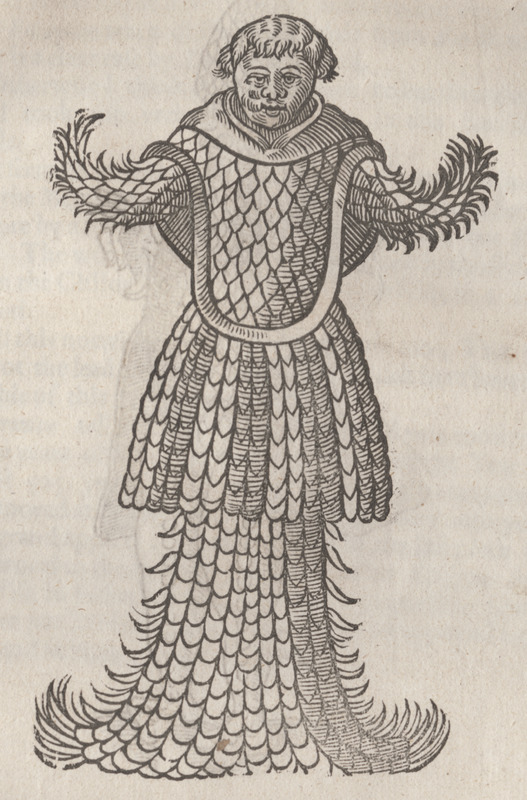Search
-
 Still image
Still imageEffigies Danielis
Ganière, Pierre, 1663-1721An engraving of Daniel, flanked by a lion and lioness, the four beasts from his vision depicted in the sky on either side of his head. -
 Still image
Still imageThe Vision of the Four Beasts
Doré, Gustave, 1832-1883An engraving of the four beasts which appeared to Daniel in a vision rising from the sea. -
 Still image
Still imageOlaudah Equiano of Gustavus Vassa, De Africaan
An engraved portrait of Olaudah Equiano which appears in his autobiography. -
 Still image
Still imageMonk Fish
A woodcut depicting a monstrous fish purportedly pulled from the sea in Poland, which had the appearance of a Catholic monk. -
 Still image
Still imageBishop Fish
A woodcut depicting a monstrous fish purportedly pulled from the sea in Poland, which had the appearance of a Roman Catholic bishop. -
 Still image
Still imageMap of the Four Beasts from Daniel's Vision
A woodcut depicting the four beasts described in Daniel's vision placed on a map, one each in Europe and Africa, and two in Asia. The beasts are placed in such a way that they surround the holy land. -
 Still image
Still imageThe Beasts from the Sea and Earth
An engraving of the two beasts mentioned in Revelations. On the left, is the seven-headed beast from the sea. On the hill to the right is the "lamb-horned" beast from the earth. -
 Still image
Still imageDaniel's Vision of the Four Beasts
An engraving of the four beasts which appeared to Daniel in a vision. Each beast represented a different kingdom and is labeled from left to right: Roma (Rome), Grecia (Greece), Persia, and Asyria. -
 Still image
Still imageVision que Saint Iean eut du Dragon
Le Clerc, Sébastien, 1637-1714An engraving of the dragon mentioned in Revelations, which granted power and authority to the Beast from the Sea and the Beast from the Earth. -
 Still image
Still imageVisions de Daniel touchant les quatre Monarchies, des Assyriens, des Perses, des Grecs, & des Romains
Le Clerc, Sébastien, 1637-1714An engraving of Daniel sleeping (left) as his vision of the four beasts (right) appear, each beast labeled with the kingdom they represent: Roma (Rome), Grecia (Greece), Persia, and Assyria. -
![A woodcut depicting two boys, one born with four [feet] and one born without hands or eyes and the lower body of a fish. These beings are described in the text as being portents of the coming of Islam, implying that Islam was a danger to Christians.](https://s3.us-west-2.amazonaws.com/omekacloud-main/large/P_3000000205074_P3xx/P_300000205074_P3xx-cr_PROD.jpg) Still image
Still imageMonstrous Portents of Islam
A woodcut depicting two boys, one born with four [feet] and one born without hands or eyes and the lower body of a fish. These beings are described in the text as being portents of the coming of Islam, implying that Islam was a danger to Christians. -
 Still image
Still imageThe Beast from the Sea
A woodcut of the first Beast mentioned in Revelations, which emerged from the sea. It has seven heads and ten horns. -
 Still image
Still imageThe Beasts from the Sea and Earth
A woodcut of the two beasts mentioned in Revelations. On the right, is the seven-headed beast from the sea. On the hill in the background is the "lamb-horned" beast from the earth. -
 Still image
Still imageGespängst der bösen geist
A woodcut depicting a hairy, bipedal beast, labeled as the "spook of the evil ghost," which is found in a vast desert beyond India in the land of Cathay. This type of ghost is said to lead travellers astray by mimicking the voices of their travelling companions. -
 Still image
Still imageSalamandra
A woodcut of a creature labeled as "Salamandra" (Salamander), which is described as preferring to live in fire and can be found on a mountain in the land of Chinchital in the New World. -
 Still image
Still imageThree-headed portent of Marcomirus
A woodcut depicting a being with three heads: a frog representing France, an eagle representing Rome, and a lion representing Germany. This creature preceeded the arrival of Marcomirus, a Sicambrian king who took control of a region of Gaul after moving from the Danube region into the low countries (Gelders and Holland). -
 Still image
Still imageVon wunderbarlichen dingen so in Morlande gefunden werden
A woodcut depicting a group of monstrous beings purported to be found in Africa, including a dog-headed being (cynocephalus) and a cyclops, both likely drawn from classical influences. This woodcut is also used to depict the same creatures in the section on India, where the purportedly also reside. -
 Still image
Still imageDaniel's Vision of the Four Beasts
A woodcut of the four beasts which appeared to Daniel in a vision. Each beast represented a different kingdom. -
![A woodcut depicting Martin Luther as a seven-headed monster, critiquing his deviation from Catholicism. Each head is labeled (from left to right): Doctor, Martinus, Luther, Ecclesiast, Schwirmer [Schwärmer], Visitieter, and Barrabas. This was a classic piece of Catholic propaganda, portraying Luther not only as a Doctor and Churchman, but as a Turk, a wild enthusiast (Schwarmer) and "Barrabas."](https://s3.us-west-2.amazonaws.com/omekacloud-main/large/P_300000132224_P005/P_300000132224_P005-cr_PROD.jpg) Still image
Still imageSieben Köpffe Martini Luthers vom hochwirdigen Sacrament des Altars
A woodcut depicting Martin Luther as a seven-headed monster, critiquing his deviation from Catholicism. Each head is labeled (from left to right): Doctor, Martinus, Luther, Ecclesiast, Schwirmer [Schwärmer], Visitieter, and Barrabas. This was a classic piece of Catholic propaganda, portraying Luther not only as a Doctor and Churchman, but as a Turk, a wild enthusiast (Schwarmer) and "Barrabas." -
 Still image
Still imageDas Munchkalb zu Freyberg
A woodcut depicting the Monk-Calf of Freyberg, which was born with a tonsure-like irregularity on its head, resembling the common hairstyle of a Catholic monk. -
 Still image
Still imageDer Bapstesel zu Rom
A woodcut depicting the "Papal Ass," a monster purported to have been pulled from the Tiber in Rome as a portent of the corruption of the Roman Catholic Church.